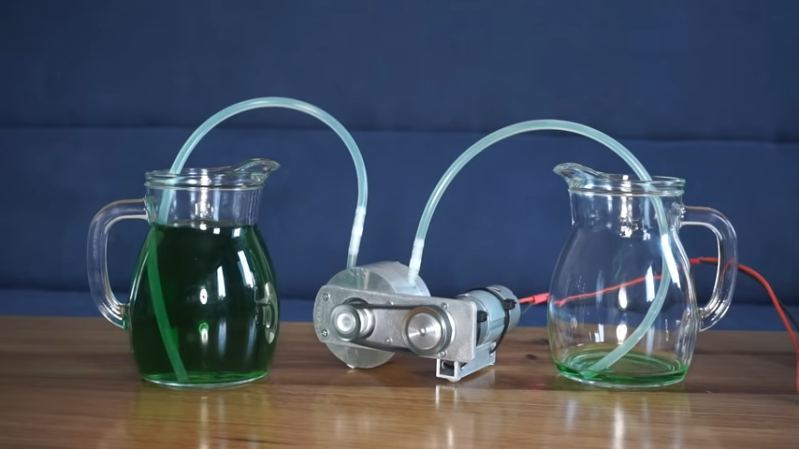The peristaltic pump is perhaps most well known for its ability to pump fluids without the pump mechanism coming into contact with the working fluid. This is key for food-safe applications and other situations where a pump could contaminate the fluid. [Maciej Nowak] has built a great example of such a pump, crafted out of aluminium from scratch.
The build video covers the machining process in detail, showing how the aluminium body was fabricated on the lathe before installing bearings and a silicone hose. The pump shaft was then fabricated, along with a set of brass rollers to press along the tube, creating the pumping action. The rollers were also lubricated in order to reduce friction on the tubing. Powering the pump is a small DC motor, sending drive via a small toothed belt, giving the finished build quite an industrial look.
We’re used to seeing plenty of 3D-printed pumps about the place. This build, while it requires a fully-equipped machine shop, is much tougher than anything plastic, and you could easily use it to break a window in an emergency too, an obscure feature nevertheless requested by some discerning pump customers.
[Maciej] shows off the build by pumping some green liquid, noting the peristaltic design requires no priming which makes operation much easier. It’s also bidirectional, and can be run very slowly if required.
Overall, it’s a build that shows off the benefits of working in metal as well as the great features of the peristaltic pump design. Video after the break.
















“STOUT PERISTALTIC PUMP”
Do you mean a robust pump or a pump that pumps dark beer?
I’d be good with both.
Does the pumps match with a Louis Vuitton handbag ?
Only for stout women.
B^)
Green liquid? I thought stout was a dark brown!
B^)
It’s Saint Patrick’s day somewhere.
Peristaltic pumps are really not that great… except for two characteristics which, together, make them THE choice for certain specific applications.
The first feature is that they are positive displacement pumps that can deliver precise quantities of fluid based upon the number of shaft rotations. (To take advantage of this you really need a better driver than the motor depicted– either a stepper motor or a DC motor with an encoder wheel) If you cease rotation, delivery stops and the delivery tube is sealed (pinched off).
The second feature of the pump is the complete isolation between the fluid and the pump machinery itself. This not only protects the pumped medium from machine contaminants (like grease, metal particles, or germs) but it protects the machinery as well, from the effects of corrosive fluids (like acids or oxidizers.) A pump like this can be unconditionally cleaned and sterilized.
It is these features that make peristaltic pumps the go-to pump for medical equipment and reagent delivery systems.
Tell me you didn’t read the first sentence of the article, without telling me you didn’t read the first sentence of the article.
I don’t get the need to blindly explain things to people who didn’t ask for an explanation, much less when the information provided is available on wikipedia.
The common medical ones don’t have steppers anymore, probably for cost reasons.
There are three plungers that press against the tube. Top and bottom square ones that act as direction gates and a central rectangular one that causes the fixed displacement that is the unit of measurement.
The gates open and close: to open the input for incoming fluid before the rectangular one lifts away from the tube to draw in fluid. Then the “in” gate closes and the “out” gate opens and the rectangle one presses back down for one unit of displacement. Rinse repeat.
The default state of the three gates/ displacer is not the same, some “open” with solenoid / motor operation and some are the opposite. This is probably so that the “failure mode” prevents fluid transferring via gravity.
You’ve also completely ignored their mixed media pumping capability: You can pump fluids with a significant amount of solids mixed in without sealing or clogging issues. You also do not pulverise the solids in suspension, which is important for certain tasks (e.g. transporting blood).
A double one would be perfect for mixing resins that can be mixed by equal volumes. Just build the pump to fit two tubes in parallel.
By using different internal-diameter tubes, you can pump a constant ratio of two liquids.
This used to be done in clinical analysers (might still be, too).
Very nice! Unfortunately, I need a hack that doesn’t require a lathe.
Maybe a Lego version!?
That would be cool to see
Is this the kind of pump used in heart/lung machines ? I remember the problems with long term usage is the damage to blood platelets.
Neat build, could be made more efficient with more wheels. I had to wonder though, why are you cutting parts with a hacksaw on a lathe?